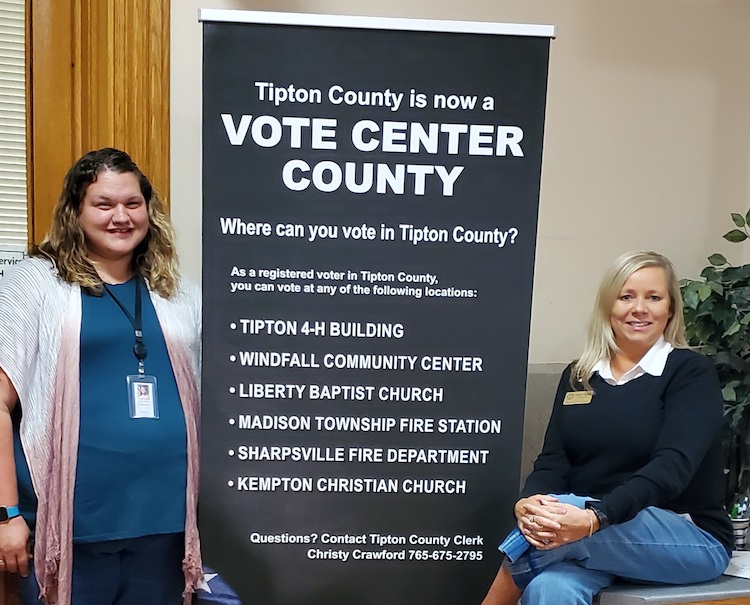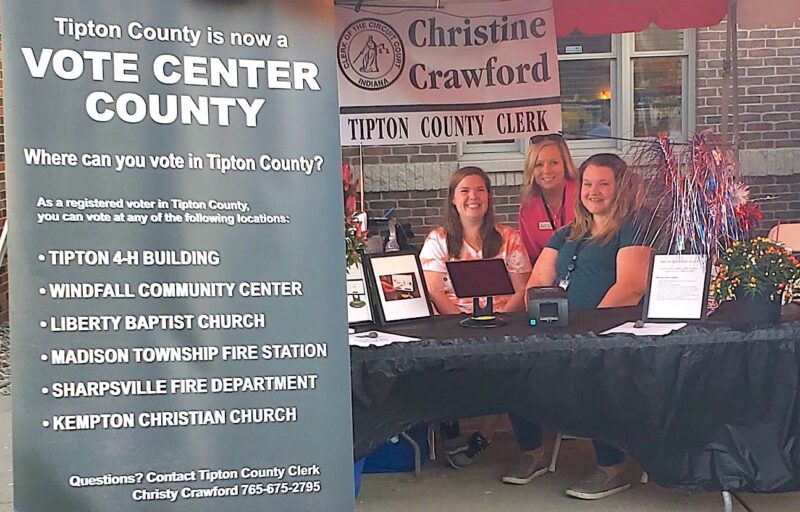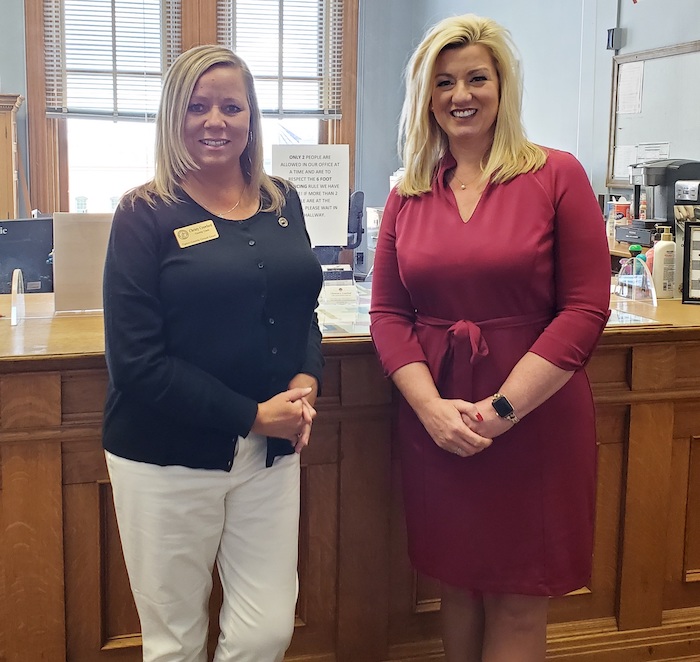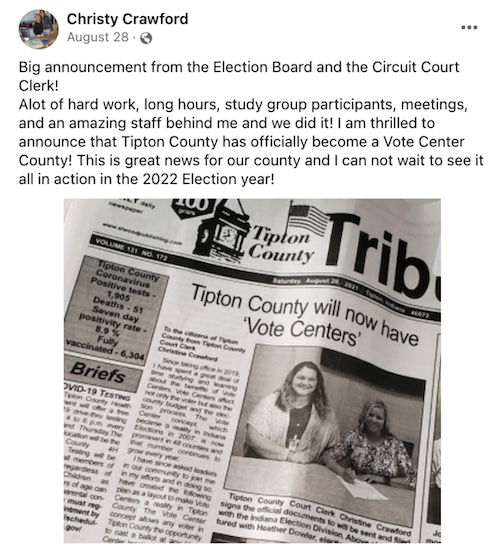Tipton County, Indiana Uses a Study Committee to Research Vote Centers
This spotlight was featured in our ELECTricity newsletter in November 2021. Sign up to receive more success stories from election offices across the country.
In the constantly evolving field of election administration, doing what’s best for voters sometimes means making big changes. For some election officials, that may look like purchasing new equipment or developing programs to address a specific issue. For others, it might mean revamping their election website. But before adopting a new innovation, you may want to conduct research to determine how to create a smooth transition for voters. In Tipton County, Indiana, election officials used a study committee to do just that.
Transitioning to vote centers in Indiana
Tipton County, Indiana is a rural community located an hour north of Indianapolis. It’s home to about 11,700 registered voters who are enthusiastic about participating in elections—the county had a 91% voter turnout rate in the 2020 Presidential Election. Christy Crawford is the Tipton County Circuit Court Clerk, and she’s helping to make changes that she thinks will boost that turnout rate even more.
In the past 15 years, 50 other Indiana counties have adopted the vote center model. Under this system, a voter is not assigned to any specific precinct. Instead, they can cast their ballot at any vote center location within the entire county. Watching more and more of her fellow election officials transition to the vote center model got Christy thinking. “I was listening to fellow Circuit Court Clerks discuss their vote centers,” she says, “and I kept asking myself ‘why not us?’”

Assembling the study committee
Vote centers have their advantages—they’re designed for voter convenience, which can boost turnout, and they can reduce costs. But every solution has tradeoffs. Potential drawbacks include up-front technology costs, and voter confusion if voters aren’t educated about the transition. Vote centers also mean voters lose the civic tradition of voting at the same place, with the same people, every election.
After doing her research, Christy determined that vote centers would be a good fit for Tipton County. But she wanted to make sure that she rolled out the new system in a way that would be convenient for voters. So she decided to assemble a study committee to investigate where the vote centers should be located, and how voters felt about the change.
Christy’s first step was to recruit the committee members. “When I started thinking about who I wanted on the study committee, I knew that I wanted it to be a group of voters who came from a variety of backgrounds,” Christy says. She was able to recruit members who reflected the residents in her county. They were both young and old, Republicans and Democrats, women and men, all living in various areas of the county. The group included a college freshman studying political science who had served as a poll worker in the past. County leaders like the Commissioner, Councilman, and IT Director also joined. “Our County Attorney and myself rounded out the members of the study committee along with my Election Deputy,” says Christy.
Bringing the members together
With the committee confirmed and excited about digging into the details, the next step was to bring the members together. “Our first meeting was more of an introductory session with each person introducing themselves and speaking about their experience with elections,” says Christy. She put together a presentation about what vote centers are and how they operate. Additionally, she provided a map of the county, along with population statistics.
In subsequent meetings, the committee members put various scenarios into play to decide which locations would work best for the vote centers. Christy posed various hypothetical questions to the group so they could consider factors such as where people work, shop, and send their kids to school. After working through these questions together, the committee decided on six vote center locations.

While these meetings were productive, Christy acknowledges the difficulty of coordinating with 10 people who are all active members of the community. “If someone was not able to join us for a meeting, I would reach out to them on the phone or email or even in person to hear their thoughts or ideas,” she says. “I wanted to make sure that we all agreed on what we were about to implement.”
Making the change
In August 2021, Tipton County made the official transition to a vote center county. Among the advantages of this change, Christy expects a decrease in phone calls. In past elections, the office received dozens of calls when voters showed up at the wrong precinct, requiring her staff to look up each voter’s correct precinct. “This would hold up the lines, make the voter feel uncomfortable, and cause the workers anxiety,” says Christy. And some voters didn’t go to their correct precinct afterwards, so the mixup dissuaded them from voting entirely. The committee thinks that vote centers should help address these issues. “No longer will they feel rejected for being in the wrong precinct,” says Christy. “No longer will they be pulling in at the last minute because they had to drive across town to get to their polling location.”
The study committee also recognized the potential to cut down costs. With vote centers, Tipton County will cut their number of polling locations in half, from 13 to just 6 vote centers. “That means half of the fees for building rentals, pay for poll workers, expenses for meals, printing off poll books, less ink, and less overall supplies,” says Christy. Thanks to these savings and a grant from the State of Indiana, Christy was able to purchase e-poll books to modernize the check in process. “The idea of not having large paper books to lug around and file through looking for names will be wonderful, especially for my older workers,” she says.
Engaging with voters
Christy and the study committee were on the same page about the value of vote centers. But they wanted to ensure that voters felt the same way. So Christy gave the committee members another assignment. She asked them to talk to their friends and family and find out what they thought about vote centers. “What we found was people were either really excited about them and thought it was long overdue, or people did not know enough about them and were reluctant,” says Christy. With that, she and her team decided to go out into the community and engage with eligible voters.

In September, Christy and her team set up a booth at the 53rd Annual Tipton County Pork Festival. They handed out fliers that announced the 6 vote center locations, and had an e-poll book available for live demonstrations. “We met with many people who were happy with the changes, and a few who had no idea what a vote center was,” says Christy. She even spoke with someone who said he didn’t like the vote center concept and wouldn’t vote in the future. Christy took about 30 minutes explaining and demonstrating the process to him, and was successful in changing his mind. She says, “He laughed and said he had no clue it was that easy!”
Christy plans to attend many more community events to educate the public about the switch. She looks forward to speaking to members of the Kiwanis club and local sororities. She will also attend local fire department chili suppers and will bring a presentation to high school students. Apart from these events, Christy’s team is using press releases and social media to raise awareness of the change. And in January 2022, her office will send a postcard to every registered voter. That way, they’ll know about the vote center locations well before the first elections take place under the new system.

and offered her full support for the transition to vote centers.
Preparing for a change in your election office
If you’re considering making the switch to vote centers—or making any innovation in your office—Christy suggests being patient with voters. “This is a change, and a lot of people are afraid of change, especially if they do not understand it,” she says. Christy also recommends being ready to talk about the new system and engage with voters everywhere you go.
No matter what big change you’re hoping to implement in your election office, a study committee can help you gather the critical information you need to prepare. But if a study committee doesn’t seem like a good fit for your election office, there are other options. For instance, Boulder County, Colorado created an online survey where voters can share recommendations for vote center locations. Sangamon County, Illinois conducted an outreach tour, traveling to villages to gather suggestions about how to improve local elections. Madison, Wisconsin uses a process guide to examine how proposed changes will affect communities of color and low-income populations. Whatever methods you use, taking the time to prepare before implementing a change will benefit your staff and your voters.
Do you have any questions about switching to vote centers or setting up a study committee? You can reach out to Christy at [email protected] and she’d be happy to help.
